Bioflavonoids, also known as vitamin P due to their effect on vascular permeability,1 are a group of compounds that are found throughout many plants, fruits, vegetables, and leaves. Bioflavonoids belong to the polyphenol group of plant compounds2 which are an extensive group of phytochemicals produced by plants in response to stress as a plant defence mechanism.3 To date over 8,000 different polyphenols have been identified.3 Though polyphenols differ in chemical structure, all share the same structural feature of an aromatic ring and at least one hydroxyl group.3 (See Figure 1)
Vitamin C and bioflavonoids – the perfect pair
First discovered by accident while trying to isolate vitamin C, Hungarian biochemist Albert Szent-Györgyi observed that the medicinal benefits of vitamin C were enhanced when used in combination with bioflavonoids rather than using vitamin C alone.4
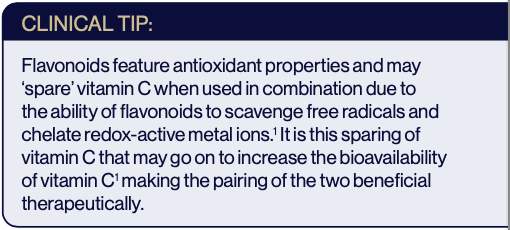
Bioflavonoids are often found in combination in supplements rather than in isolation, mimicking how they are found in nature and are used frequently due to their ability to modify a range of health conditions.5
Bioflavonoids and immunity
Bioflavonoids may assist with modulating immunity via a range of functions including regulation of T-lymphocytes6 as well as suppression of pro-inflammatory transcription factors such as NF-kB.7
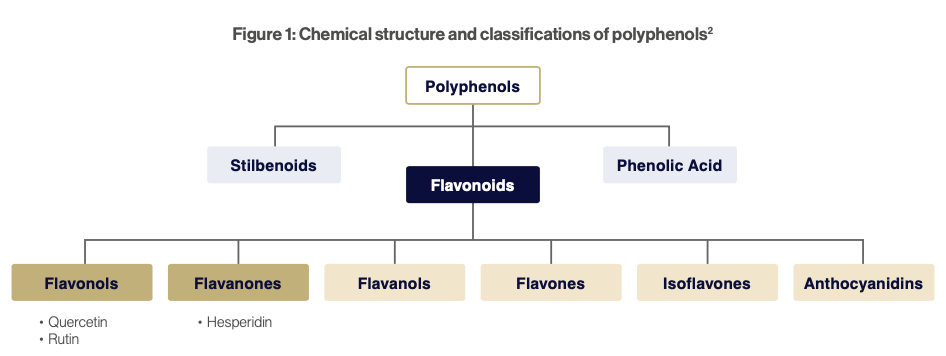
QUERCETIN
Quercetin (3,3′,4′,5,7-pentahydroxyflavone) is the most studied bioflavonoid and is found in a range of food sources including apples, berries, Brassica vegetables, capers, grapes, onion skins, shallots, as well as several herbal medicines including Sambucus canadensis, Ginkgo biloba and Hypericum perforatum.7 Quercetin exerts antioxidant, antihistamine, and anti-inflammatory properties.8
Quercetin as an anti-allergic
Quercetin regulates T helper 1 and 2 (Th1/Th2) and T regulatory and T helper 17 (Treg/Th17) ratios, modulating the immune system and reducing inflammation.6,9

In a randomised controlled trial involving 66 individuals with seasonal allergies, 200 mg/day of quercetin consumed for 4 weeks was shown to significantly reduce eye itching, sneezing, nasal discharge, and sleep disturbance when compared to placebo10 making it a compelling choice when treating seasonal allergies.
Quercetin as an anti-viral
Quercetin has also been studied in various models of viral infection including Orthomyxoviridae (influenza family) and Coronaviridae (SARS-CoV-2).11 As an anti-viral, quercetin works via multiple mechanisms including the inhibition of polymerases and proteases, the suppression of DNA gyrase, reverse transcriptase, and the binding of viral capsid proteins preventing virus entry into cells.11
COVID-19
Meta-analysis examining quercetin as an adjuvant therapy for individuals with COVID-19 observed a reduced length of hospitalisation and reduced risk of ICU admission in patients receiving the adjuvant treatment.12 A 2021 study examining the use of quercetin in those with COVID-19 observed that individuals who received quercetin in addition to standard care, tested negative to SARS-CoV-2 earlier, demonstrating their ability to clear the virus quicker. Furthermore, those taking quercetin were able to reduce the severity of symptoms quicker when compared to individuals who received standard care only.13 Interestingly, despite the known anti-inflammatory effects of quercetin, some studies showed no effect on C-reactive protein (CRP) levels.14
Absorption
Quercetin has low solubility in water with approximately 93% of orally administered quercetin lost in the gut as a result.15 Bioavailability can be increased with the co-ingestion of lipids.16 Quercetin combined with sunflower phospholipids has been shown to increase absorption up to 20-fold.13 Simultaneous ingestion of quercetin with vitamin C, folate, and additional flavonoids also improves bioavailability.17
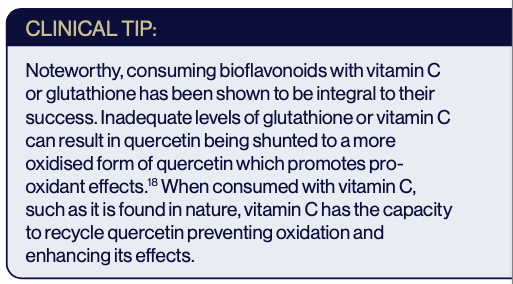
Cautions
Oral intake of quercetin in humans appears to be well tolerated with doses up to 1,000 mg/day not associated with major side effects over a duration of 12 weeks. High doses may cause mild stomach discomfort and nausea if quercetin is taken on an empty stomach. This may be ameliorated by consuming food first.

HESPERIDIN
Hesperidin is a flavone glycoside found in high concentrations within the citrus family including oranges and lemons. It possesses a variety of benefits including anti-inflammatory, antioxidant,19 and immune-modulating properties.
Hesperidin content is influenced by type, part, and maturity of the citrus fruit, with the flavedo (the coloured outer layer of the peel) and the albedo (a white soft middle layer part) containing higher amounts of hesperidin (see Figure 2).20
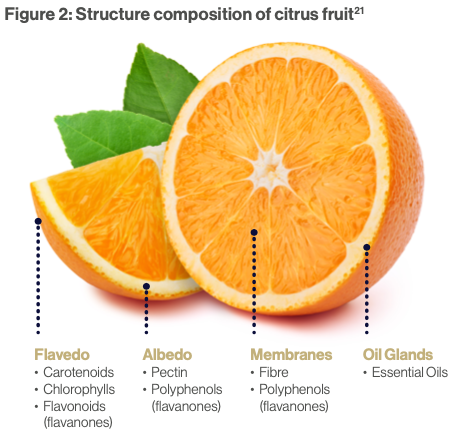
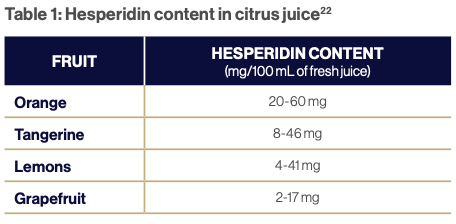
Hesperidin and immunity
Treatment with hesperidin of influenza-infected cells has been shown to enhance host immunity. Rodent studies have shown that treatment with hesperidin may increase NK cells activity and T helper cells in the thymus.22
Experimental data also demonstrates that hesperidin can inhibit 3-chymotrypsin-like protease 3 (3CLpro) interfering with SARS-CoV2 replication,23 as well as disrupting the binding point between the spike protein of SARS-CoV2 and angiotensin-converting enzyme 2 (ACE2) receptors.24 Hesperidin’s ability to interfere with viral entry through ACE2 receptors as well as reduce the release of pro-inflammatory mediators protecting against virus-induced cytotoxic damage has led to it being suggested as a possible prophylactic agent against COVID-19.25 Despite this, a human clinical trial examining 1 gram of hesperidin over 2 weeks in individuals during the third wave of COVID-19 failed to observe statistically significant benefits when compared to placebo.23 This may be because it was used in isolation, rather than synergistically with vitamin C and bioflavonoids as well as due to individual variations in human gut microbial diversity.
Hesperidin is transformed into hesperetin by bacterial flora in the gut intestine.26 An individual’s gut microbiome is therefore also a factor that may influence an individual’s response to hesperidin.

RUTIN
Rutin is a polyphenolic flavonoid found in buckwheat, onions, oranges, lemons, as well as in beverages such as wine and black tea.27 Rutin is made up of one molecule of quercetin in the form of an aglycone as well as rutinosei making it structurally similar to quercetin.27
Rutin possesses immune-modulatory and anti-viral activity, with experimental research suggesting that rutin may work as an ACE2 inhibitor, making it useful for the management of COVID-19 as the SARS-CoV2 virus enters its target cells via ACE2.28
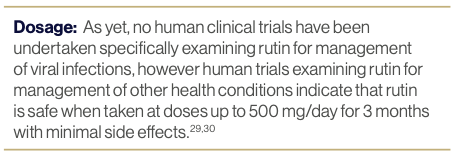
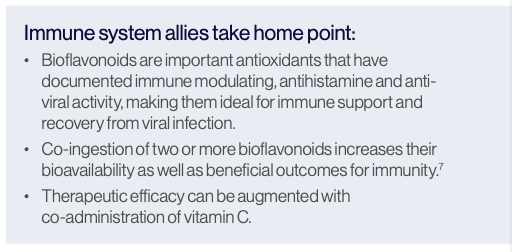
Download a pdf copy of this article
References
1 CarrAC,VissersMC.Syntheticorfood-derivedvitaminC—aretheyequallybioavailable?.Nutrients.2013Oct28;5(11):4284-304.
2 Arora I, Sharma M, Tollefsbol TO. Combinatorial epigenetics impact of polyphenols and phytochemicals in cancer prevention and therapy. International journal of molecular sciences. 2019 Sep 14;20(18):4567.
3 Shakoor H, et al. Immunomodulatory Effects of Dietary Polyphenols. Nutrients. 2021 Feb 25;13(3):728. 4
4 Murray, M. 81 - Flavonoids—Quercetin, Citrus Flavonoids, and Hydroxyethylrutosides (Pg 613-619.e2) in Pizzorno, J. & Murray, M. (2020) Textbook of Natural Medicine (5th Ed.) Churchill-Livingstone
5 Ullah A, et al. Important Flavonoids and Their Role as a Therapeutic Agent. Molecules. 2020 Nov 11;25(22):5243.
6 Ke X, et al. Quercetin improves the imbalance of Th1/Th2 cells and Treg/Th17 cells to attenuate allergic rhinitis. Autoimmunity. 2023 Dec;56(1):2189133.
7 Li Y, et al. Quercetin, Inflammation and Immunity. Nutrients. 2016 Mar 15;8(3):167.
8 Di Pierro F, et al. Possible Therapeutic Effects of Adjuvant Quercetin Supplementation Against Early-Stage COVID-19 Infection: A Prospective, Randomized, Controlled, and Open-Label Study. Int J Gen Med. 2021 Jun 8;14:2359-2366
9 Jafarinia M, et al. Quercetin with the potential effect on allergic diseases. Allergy Asthma Clin Immunol. 2020 May 14;16:36.
10 Yamada S, et al. Effects of repeated oral intake of a quercetin-containing supplement on allergic reaction: a randomized, placebo-controlled, double-blind parallel-group study. Eur Rev Med Pharmacol Sci. 2022 Jun;26(12):4331-4345.
11 Di Petrillo A, et al. Quercetin and its derivates as antiviral potentials: A comprehensive review. Phytother Res. 2022 Jan;36(1):266-278.
12 Cheema HA, et al.. Quercetin for the treatment of COVID-19 patients: A systematic review and meta-analysis. Rev Med Virol. 2023 Mar;33(2):e2427.
13 di Pierro, F. et al. (2021). Possible therapeutic effects of adjuvant quercetin supplementation against early-stage COVID-19 infection: A prospective, randomized, controlled, and open-label study. International Journal of General Medicine, 14, 2359–2366.
14 Ziaei S, et al. The effect of quercetin supplementation on clinical outcomes in COVID-19 patients: A systematic review and meta- analysis. Food Sci Nutr. 2023 Sep 26;11(12):7504-7514.
15 Chen T, et al. Potential Role of Quercetin in Polycystic Ovary Syndrome and Its Complications: A Review. Molecules. 2022 Jul 13;27(14):4476..
16 Riva A, et al. Improved Oral Absorption of Quercetin from Quercetin Phytosome®, a New Delivery System Based on Food Grade Lecithin. Eur J Drug Metab Pharmacokinet. 2019 Apr;44(2):169-177.
17 Konrad M, et al. Evaluation of Quercetin as a Countermeasure to Exercise-Induced Physiological Stress. In: Lamprecht M, editor. Antioxidants in Sport Nutrition. Boca Raton (FL): CRC Press/Taylor & Francis; 2015. Chapter 10.Available from: https://www.ncbi.nlm.nih.gov/books/NBK299055/
18 Colunga B et al. Quercetin and Vitamin C: An Experimental, Synergistic Therapy for the Prevention and Treatment of SARS-CoV-2 Related Disease (COVID-19). Front Immunol. 2020 Jun 19;11:1451.
19 Buzdağlı Y, et al. Effects of hesperidin on anti-inflammatory and antioxidant response in healthy people: a meta-analysis and meta- regression. Int J Environ Health Res. 2023 Dec;33(12):1390-1405.
20 Pyrzynska K. Hesperidin: A Review on Extraction Methods, Stability and Biological Activities. Nutrients. 2022 Jun 9;14(12):2387.
21 Nieto G, Fernández-López J, Pérez-Álvarez JA, Peñalver R, Ros G, Viuda-Martos M. Valorization of citrus co-products: Recovery of bioactive compounds and application in meat and meat products. Plants. 2021 May 26;10(6):1069.
22 Ruiz-Iglesias P, Estruel-Amades S, Camps-Bossacoma M, Massot-Cladera M, Franch À, Pérez-Cano FJ, Castell M. Influence of Hesperidin on Systemic Immunity of Rats Following an Intensive Training and Exhausting Exercise. Nutrients. 2020 May 1;12(5):1291. doi: 10.3390/nu12051291. PMID: 32369998; PMCID: PMC7282260.
23 Dupuis J, et al. Fourteen-Day Evolution of COVID-19 Symptoms during the Third Wave in Nonvaccinated Subjects and Effects of Hesperidin Therapy: A Randomized, Double-Blinded, Placebo-Controlled Study. Evid Based Complement Alternat Med. 2022 Nov 3;2022:3125662.
24 Cheng FJ, et al. Hesperidin Is a Potential Inhibitor against SARS-CoV-2 Infection. Nutrients. 2021 Aug 16;13(8):2800.
25 Haggag YA, et al. Is hesperidin essential for prophylaxis and treatment of COVID-19 Infection? Med Hypotheses. 2020 Nov;144:109957.
26 Estruel-Amades S, Massot-Cladera M, Pérez-Cano FJ, Franch À, Castell M, Camps-Bossacoma M. Hesperidin effects on gut microbiota and gut-associated lymphoid tissue in healthy rats. Nutrients. 2019 Feb 2;11(2):324.
27 Yang J, et al. Conversion of Rutin to Quercetin by Acid Treatment in Relation to Biological Activities. Prev Nutr Food Sci. 2019 Sep;24(3):313-320.
28 Agrawal PK, et al. Rutin: A Potential Antiviral for Repurposing as a SARS-CoV-2 Main Protease (Mpro) Inhibitor. Natural Product Communications. 2021;16(4).
29 Bazyar H, et al. The effects of rutin flavonoid supplement on glycemic status, lipid profile, atherogenic index of plasma, brain-derived neurotrophic factor (BDNF), some serum inflammatory, and oxidative stress factors in patients with type 2 diabetes mellitus: A double- blind, placebo-controlled trial. Phytother Res. 2023 Jan;37(1):271-284.
30 Mathrani A,et al.. Effect of a 12-Week Polyphenol Rutin Intervention on Markers of Pancreatic β-Cell Function and Gut Microbiota in Adults with Overweight without Diabetes. Nutrients. 2023 Jul 28;15(15):3360.


